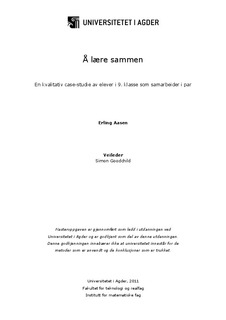| dc.description.abstract | The theme of this master dissertation has been peer collaboration. The main goal of the study has been to illuminate factors that affect pupils working together and whether these factors can be viewed in the context of pair composition based upon student ability.
The empirical data is collected in a grade 9 lower secondary school classroom. I used an ethnographic approach where a qualitative method was chosen to answer the research question. The data is gathered by video filming pupils task-related work in pairs, and interviewing the observed pupils and their teacher.
The literature discussion focuses on collaborative/cooperative learning, peer tutoring and group work. This paper examined pupils sitting in pairs, working on common tasks. Many researchers define such work outside the scope of cooperative /collaborative learning and peer tutoring, and will require clear frameworks for these methods. My experiences are that the observed form of collaboration has potential for improved learning between pupils. It has been a conscious choice to point to relevant factors from well-defined methods. Research results from collaborative/ cooperative learning, peer tutoring and group work are presented and discussed in relation to my findings.
To structure the data for the analysis I have chosen to use analytical categories based on research from Kieran and Dreyfus, and Mercer. These categories reveal several episodes with different potentials for learning. The data is organized in the collaborative categories defined by these researchers. In the analysis I present the pairs, different cases of interaction and a general description of pupils’ cooperation.
My results indicate that composition of the pairs based on ability provides directions in their work, but there are challenges in relation to pupils' different abilities. Two high achieving students can act very differently in a collaborative work situation, students' ability to cooperate varies. Thus, composition should be based on several reasons. Cooperation should be given time, and be encouraged. Requiring homogeneous couples to work together should be considered. Trustworthiness and security allows students to more easily communicate together. Friendship is a factor that can provide to this. I suggest that it will be positive for pupils to cooperate over sustained periods to become familiar with each others' mathematical knowledge. Giving and receiving help presents challenges for pupils. There were very few learning situations with apparently high potential for learning. Based on my findings I encourage teaching pupils how to work in pairs. My data, and research on group composition, shows that a medium ability student working with a low-ability student can be difficult. I would be careful about letting these pupils work together.
Kieran C, & Dreyfus, T. (1998). Collaborative versus individual problem solving: Entering another`s universe of thought. In A. Oliver & K. Newstad (Eds.) Proceedings of PME22, Vol. 3, Stellensbosch, South Afrika, University of Stellebsbosch, pp. 112-119.
Mercer, N. (1995). The Guided Construction of Knowledge: Talk amongst teachers and learners (Vol. 1): Multilingual Matters Ltd. | en_US |
